Flavia Dzodan, of Red Light Politics, sent in a link to the Global Media Monitoring Project’s new report, Who Makes the News? The document looks at the gender imbalance in news production, based on an analysis of 1,281 newspapers, TV, and radio stations in 108 countries on November 10, 2009.The results indicate that women are still under-represented as news subjects, and that stories about women often reinforce stereotypes (focusing on women in family roles, using women for “ordinary person” quotes rather than experts, emphasizing women in stories about criminal victimization, birth control, and so on but not economic policy or politics, etc.).
A note on the methodology:
The research covered 16,734 news items, 20769 news personnel (announcers, presenters and reporters), and 35,543 total news subjects, that is people interviewed in the news and those who the news is about.
Internet sources were analyzed separately.
Overall, the analysis shows that both local and international news show a world in which men are highly over-represented as subjects, though women are more likely to be represented as victims, to have their family status mentioned, or to be in newspaper photos:
Interestingly, those reporting the news are more gender balanced, indicating that having more women producing the news doesn’t lead to an automatic reduction in under-representation of women in the news:
The representation of women as news subjects differs widely by category of news, from 12% of subjects in stories about agriculture to 58% in stories about family relations or single parenting (and 69% in a category they called the “girl-child,” stories about cultural practices impinging on or harming specifically female children, as opposed to children in general):
I’ll put the rest after the jump since there are quite a few images.
Female news subjects generally hold stereotypically female occupations. Here is the % female in different occupations that were clearly identified in the analysis:
Female news subjects also serve different purposes:
And female subjects are more likely to have their family status mentioned than are male subjects:
Finally, the analysis found that news stories were much more likely to reinforce than challenge gender stereotypes, with less than 10% of stories in any of the major categories challenging them:
The percent reinforcing stereotypes varies greatly by region; however, the % challenging stereotypes is much more stable, with only Latin American media outlets standing out:
Stories that reinforce gender stereotypes seem to be somewhat less likely to have female reporters, while those that challenge them are more likely to have female reporters:
You can download the full report here.

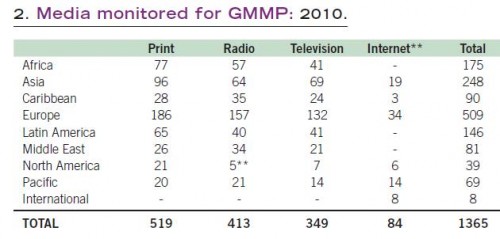
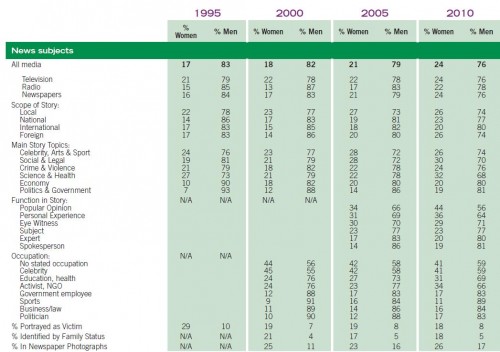
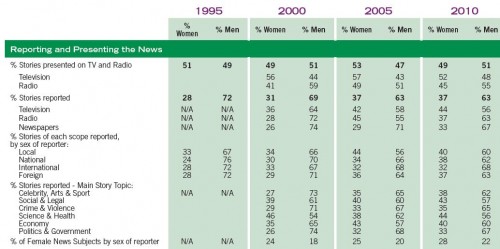
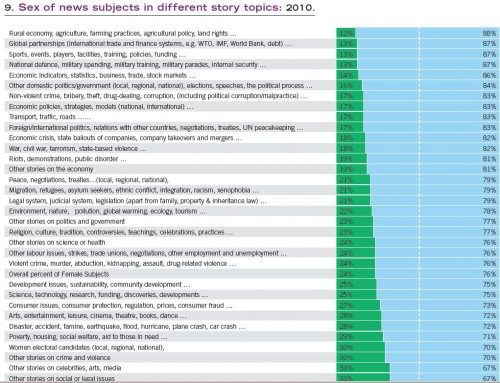
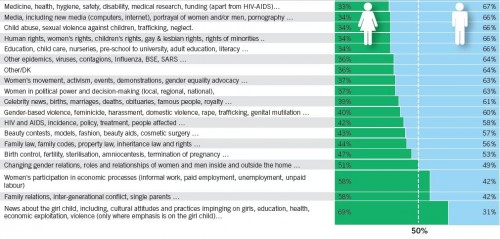
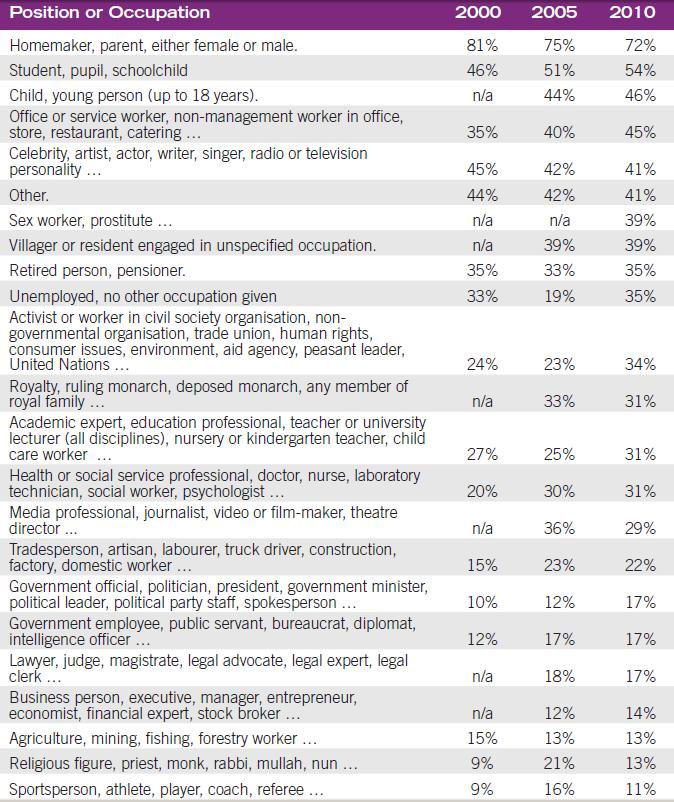

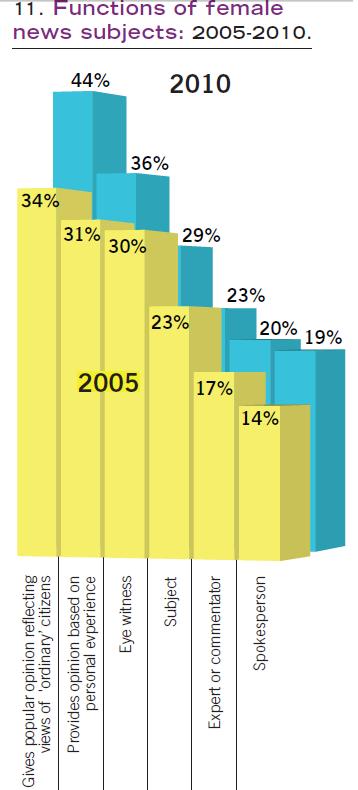
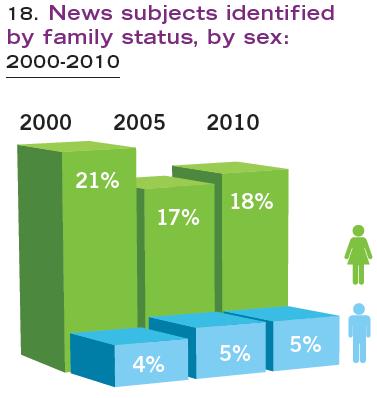
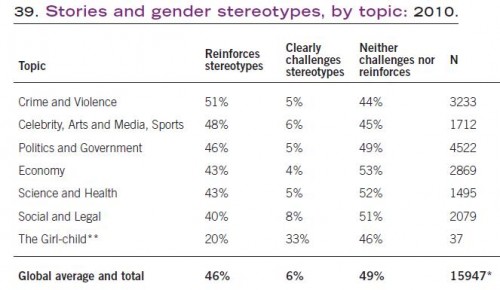
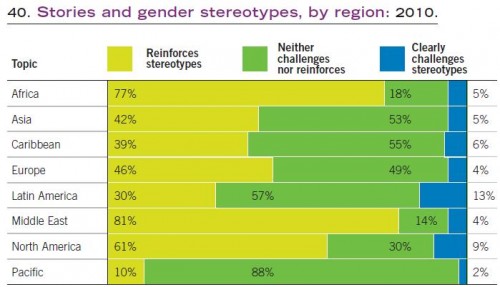
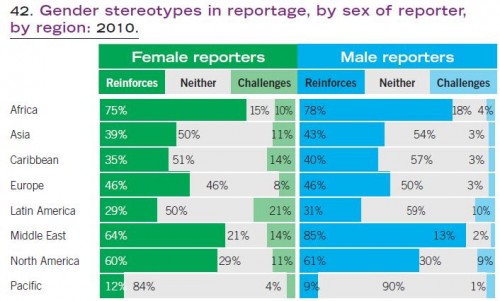
Comments 9
MPS — October 4, 2010
All very interesting, and too much for me to fully process at the moment.
However one thought occurs to me, which is in a society that has unequal gender distributions across occupations, it should be expected that news reporting of said occupations will reflect unequal gender distributions. And insofar as stereotypes properly gauge such distributions, they will reinforce stereotypes. For instance, I guess ~ 10% of academic physicists are female. This fits the stereotype. And if news sources fairly sampled the physicists they use to report stories on or seek expert advice from, then only 10% would be female (assuming talent level between male / female physicists is comparable).
What We Missed — October 4, 2010
[...] Images on how women are underrepresented as news subjects in the media. And when they are? Stereotypes [...]
md — October 4, 2010
Considering that my local news seems to be almost entirely devoted to sports, local politics, business, statistics, and the stock market and according to this data, these topics feature men almost 90% of the time, I wonder how much *time* is devoted to featuring men as compared to women on an average news cast.
AC — October 4, 2010
As a local newspaper reporter (and a woman), I do my best to quote the genders equally. Unfortunately, as another poster noted, the gender balance is off in many professions, leading to an imbalance when it comes to experts, government officials, teachers, etc.
But in quoting people outside the context of their professions, I have found that in many cases men are more willing to offer an opinion to a reporter and to allow their names to be used. Perhaps more men have been socialized to believe their opinions are important and worth hearing.
Fernando — October 4, 2010
I worked in the news here in Brasil and the newstaff was overwhelmingly female. Same goes for journalism schools, majority of female students. This is more or less the rule in the rest of the country too, from what I know.
I had the chance of working in two major newspapers of my state, and what I noticed was that newspapers weren't too confident about challenging anything taken as "common sense". That includes some sexist societal norms. This is sometimes taken as expressing your own opinion in the piece, which is not something journalists are supposed to do. Even if you don't do it with your own words.
Trying to be objective and partial leads to airing opinions that won't be disagreed with. For an instance, if you decide to quote someone stating something controversial, you need to have someone else to counter-quote that, and that's not always a practical thing to do when it comes to more complex issues.
Another thing is that certain angles are taken as good for selling newspapers. Like, for an instance, stories of sexual violence.
gasstationwithoutpumps — October 4, 2010
The interesting thing for me is that the Pacific region is shown as neither supporting nor challenging gender stereotypes. Is this an artifact of the languages, or better training for the journalists? I'm much more impressed by that than by the Latin American region spicked out by the author.
Too few women in science and tech: links (1) « Into Oblivion — October 14, 2010
[...] Women and the News: An International Comparison [...]
Too few women in science and tech: links (1) | Into Oblivion — March 14, 2014
[…] Women and the News: An International Comparison […]